Gigabyte P55A Series Motherboards
featuring the UD3R and UD6
I recently tested one of the first P55 motherboards to hit the market from Gigabyte, the P55-UD3R.
Please review my article here: http://computinginjapan.blogspot.com
A quick recap for those of you who missed it; I found it to be an extremely competent platform, perfectly well suited to overclock, but with lots of performance built in at stock settings as well, thanks to Intel TURBO.
Gigabyte has not been resting on it's laurels however, and today I'm beginning a series on their newest additions to the P55 family, the P55A-UD3R and the P55A-UD6. Both of which feature two SATA 6Gb/s ports, and two USB 3.0 ports! Although I do not have a SATA 6Gb/s drive to test performance of the new interface...part one of my investigation is an exploration of the new USB 3.0 interface using the UD6 motherboard. These tests do not involve extensive or extreme overclocking. I'll be looking more at the overclocking potential of these boards very soon.
Part 1 - USB 3.0 "SuperSpeed USB"
First I'd like to cover a couple basic differences between USB 2.0 and SuperSpeed USB (from here forward, referred to as "SSUSB"). The first and most obvious difference is the bandwidth. USB had a theoretic bandwidth cap at 480Mb/s (60MB/s), but in realistically you'd only get a maximum of about 300Mb/s (38MB/s), or roughly 63% of the theoretical maximum. SSUSB raises the bar to a whopping 5Gb/s (625MB/s), if we apply the same 63% to that figure, we come up with an expected limit of 3150Mb/s (394MB/s) which would easily provide the bandwidth needed by any current generation USB device.
The second major difference in the SSUSB spec calls for more power! As in, a higher supply current for the connected device. 500mA (the USB 2.0 amount) was barely enough for the average 2.5" 5400RPM drive to operate (most need about 450mA), but to get them spinning often took a special USB cable that allowed the device to draw current from two of the PC's USB ports, allowing 1000mA. However, this is a faily clumsy approach for most people, and so many 2.5" drives avoid 5400RPM disks and stick to 4200RPM models instead. SSUSB raises the specific output to 800mA...plenty for running 5400RPM. Gigabyte decided not to stop there...why not allow users even more flexability and provide the current they really need? So very P55A board with SSUSB technology will be capable of supplying a whopping 1500mA (1.5A) to each SSUSB device!
The third big change in SSUSB, is the connection itself, the devices ARE BACKWARDS COMPATIBLE, but they will need a special cable to operate at SSUSB specs. Here are some shots of the new connection.

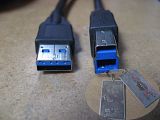
For more information on the changes in the new SSUSB standard, please visit www.usb.org
The way that Gigabyte has implemented USB3.0 on these motherboards is very interesting.
"There are two ways that our USB/SATA 3.0 works: one way is Turbo mode where it uses PCI-E lanes to communicate directly with the CPU for best performance. The other way is through the P55 chipset where it is limited to PCI-E gen 1 speed (2.5Gb/s) – when turbo mode is disabled. The point is that Gigabyte P55A boards are all about options: we provide options for the user to decide if he wants 5Gb/s SSUSB for high-speed backup or if he prefers SLI/CFX while still enjoying USB/SATA 3.0 – albeit at a lower speed. And in auto mode the system will decide for the user, i.e. if there is a 2nd VGA card then SLI/CF takes precedence, but if there is only 1 VGA card and a device is plugged into a USB/SATA 3.0 slot then superspeed data transfer takes precedence.
Key to our design is the DMI bus (10Gb/s) between the CPU and P55 chipset because any device that is connected to the chipset (audio card, RAID sub-system, even the drive with your OS) will have to share that bus. So if you’re loading the chipset’s SATA, USB 2.0 and PCI-E bandwidth then it makes sense to use Turbo mode. Adding a bridge chip (such as the PLX chip) doesn’t provide extra DMI bus bandwidth, so there is a potential bottle neck!" - source inside Gigabyte Co. Ltd.
Here is the testbed used for the following tests:
Gigabyte GA-P55A-UD6 motherboard (F3 BIOS)
Intel Core i7 870 quad core CPU at 4.4GHz, water cooled
2x 2GB Kingston HyperX at 1000Mhz (2000MHz DDR) with 7-8-7 20 1T sub-timings
16GB MTRON Pro SSD running off the Intel P55 SATA controller (for the OS)
1x or 2x Gigabyte GTX 260 with nVidia Forceware 191.07 drivers
PC Power and Cooling 750W power supply
Windows Vista 32bit
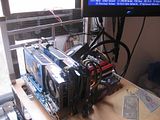
I will be testing three different devices, representing three different types of external drive usage models.
WD3200BEKT - Western Digital Scorpio Black 320GB 2.5" 7200RPM
This drive represents a moderate capacity, fast mobile drive. Right now, a drive like this require too much power to be used in a USB 2.0 application without a separate power source. But I suspect they will become a common use for the advancements brought with the SSUSB standard.
HD103SJ - Samsung Spinpoint F3 1TB 7200RPM
This drive represents an external storage solution. This type of drive is very typically used in external scenarios for data backup and for media storage. In both cases, bandwidth plays a big role because of the volumes of data that need to be moved. This has become a sore spot for USB 2.0, and I believe represents the largest usage model.
OCZSSD2-1VTX30G - OCZ Vertex SATA2 SSD 30GB
I'm including this drive to represent everything else; to see if we can find any limits imposed within the system, to represent the most extreme users who need the best of everything, and to represent the future of external storage and personal electronic devices (MP3 players, PVPs, etc...)
I will be using two different benchmarks:
ATTO Disk Benchmark v2.34
HD Tune v2.55
So, I set out to answer a few different questions. First, and most obvious, does USB 3.0 show a worthwhile upgrade over USB 2.0? Secondly, What's up with this whole "Turbo" mode for the SSUSB implemented on the Gigabyte motherboards? Thirdly, and most controversial on the forums right now, will SSUSB really take away from my graphics card bandwidth? Interested?...read on!
I used the new Buffalo 1TB SSUSB drive for testing, here are a couple more pictures:
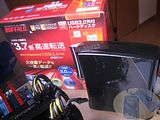
After disassembling the casing and gutting the Spinpoint from inside, I proceeded to test each of my three drives in five different ways, with two different tests. That's a total of 30 different tests. If you'd like to browse all of the screen captures, please feel free to do so. However, I've attempted to sum up the data in the following charts.
I tested each drive 5 time with each benchmark:
USB 2.0 - I just plugged into one of the USB ports on the motherboard that did not support USB 3.0 and tested from there
USB 3.0 - I plugged into one of the two available SSUSB ports on the motherboard, in the BIOS, I had SSUSB Turbo set to "disable"
USB 3.0 + SLI gaming - Here I plugged in a second GTX 260 and configured them for SLI operation. Immediately after starting the HDD benchmark, I would also start the three gaming tests in 3DMark 2003 (see below for
USB 3.0 + Turbo - I plugged into one of the two available SSUSB ports on the motherboard, in the BIOS, I had SSUSB Turbo set to "Turbo USB 3.0"
SATA - I plugged each drive into an available SATA port controlled by the Intel P55 chipset.
Here is a shot of the "Turbo USB 3.0" option in the BIOS:
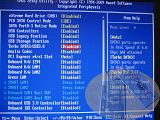




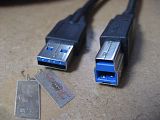
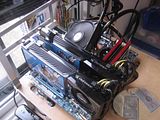
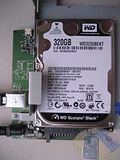
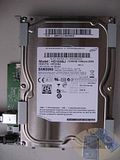
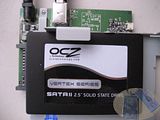
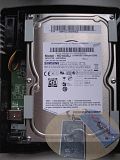



 Reply With Quote
Reply With Quote

Bookmarks